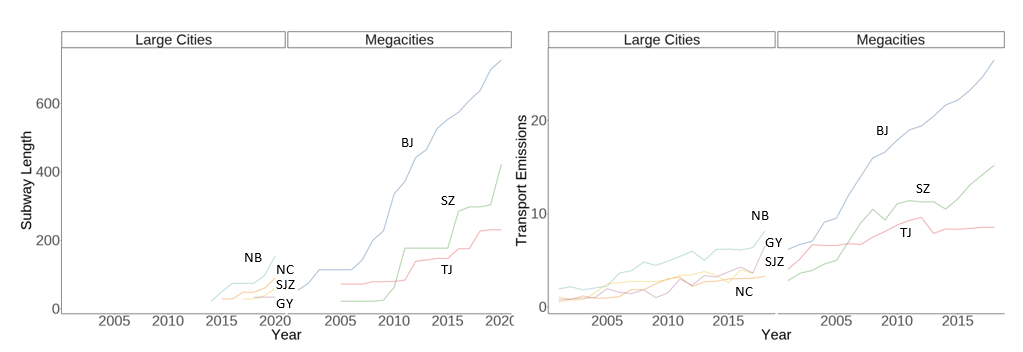TOD and Low-carbon City
September 19, 2025
Officially launched in 2017, Global Environment Facility - 6 China Sustainable Cities Integrated Approach Pilot Project (GEF China SCIAP) is designed to promote transit-oriented development (TOD) through integrated models of urban design, planning, and strategies. The project is implemented by seven large cities, including Beijing, Tianjin, Shijiazhuang, Guiyang, Nanchang, Ningbo, and Shenzhen that represent the diversity of Chinese cities, and China Ministry of Housing and Urban-Rural Development with the task to build a national TOD platform that shares data, knowledge, and best practice across cities.
GEF6 China SCIAP project envisions an evolving future of Chinese cities: better coordination of land use planning and transport infrastructure, improving equality of employment opportunities, and convenient access to affordable housing. Climate change mitigation was not in the initial project scope, but as China committed to peak carbon dioxide emissions before 2030 and achieve carbon neutrality before 2060, it would be interesting to look into the relationship between TOD and low-carbon city.
TOD strategies have great potential in carbon emissions reduction. First, TOD can facilitate transport mode shift from private automobiles to transit. Second, TOD can improve land use efficiency with compact and connected urban spaces that induce shorter trips, walking and cycling, and less vehicle miles traveled (VMT) and car ownership. IEA data showed that passenger road vehicles was the largest source of carbon emissions in transport sector in 2020 which accounts for 41% of total transport emissions, while rail emitted only 10%. However, city governments should be aware that compact urban growth programs applying TOD principles cannot efficiently reduce transport carbon emissions when failing to recognize characteristics of different cities (Landis et al., 2017), especially for the seven participating cities under GEF6 China SCIAP that represent a wide diversity of modal choices, core area development intensities, and residential densities.
Figure 1 Subway lengths, transport carbon emissions, and residential densities, 2001-2018

a) Subway System Lengths (km)[1] b) Total Transport Carbon Emissions (MMt)

Note: BJ, TJ, SJZ, NB, NC, GY, SZ stands for Beijing, Tianjin, Shijiazhuang, Ningbo, Nanchang, Guiyang, and Shenzhen, respectively.
Data source: China Emission Accounts and Datasets and China City Construction Statistical Yearbook; figures are prepared by the author.
Figure 1 describes the seven cities’ subway construction, total and per capita transport emissions, and urban densities in two groups: large cities with population between 1 to 10 million people (Shijiazhuang, Guiyang, Nanchang, and Ningbo) and mega cities with population over 10 million people (Beijing, Tianjin, and Shenzhen). These cities have undergone a period of rapid expansion of subway systems in the past two decades. Beijing’s subway reached 727 km in length in 2020, and Ningbo has put 5 lines and a total length of 154 km of subway into operation since 2014 (Figure 1a).
Transport emissions have been growing following similar trends, though mega cities’ total transport emissions are in much greater magnitude than those of large cities. Carbon emissions from transport sector of Beijing and Shenzhen increased over 300%. Emissions of the four large cities started low in 2001 with an average of 1 million metric tons (MMt), but those of Ningbo and Guiyang quickly rose to 8.17 MMt and 6.57 MMt in 2018, which were 50% higher than the national average of large cities (Figure 1b).
On the contrary, per capita transport emissions were lower in mega cities. Per capita transport emissions of Tianjin and Shenzhen stabled around 1 ton. Transport activities in the four large cities were less energy efficient as per capita transport emissions increased rapidly since 2001 (Figure 1c).
Table 1 Number of trips done by different mode choices, 2015
|
City
|
Urban Population[4]
|
Bus and Subway[5]
|
Private Vehicles and Taxi[6]
|
|
Beijing
|
1878
|
744,671
|
227,740
|
|
Tianjin
|
1278
|
187,063
|
123,799
|
|
Shenzhen
|
1138
|
349,679
|
199,361
|
|
Shijiazhuang
|
631
|
58,686
|
70,977
|
|
Ningbo
|
547
|
49,947
|
83,522
|
|
Nanchang
|
378
|
58,783
|
87,914
|
|
Guiyang
|
345
|
64,486
|
146,109
|
Data source: shared by China Academy of Transportation Sciences; table prepared by the author.
What contributed to such differences in the cities’ transport carbon emissions profiles? The first factor is travel behavior. Public transit’s ridership was much higher than trips done by passenger vehicles in Beijing and Shenzhen in 2015. But private vehicles and taxi still dominated in modal choices in Shijiazhuang, Guiyang, Nanchang, and Ningbo, where there were less population and smaller subway networks (Table 1).
Residential density is another factor that influences the seven cities’ carbon efficiency in transport sector. Denser cities could shorten residents’ commuting distance, concentrate infrastructure investment, and promote walking and cycling around transit stations. But this is not the case for Shijiazhuang, Guiyang, Nanchang, or Ningbo for now since their residential densities have been decreasing since 2001 from an average of 18 thousand people per km2 to less than 10 thousand. Beijing and Tianjin showed a similar downward trend. Their moderate population growth did not match the fast pace of spatial expansion. Only Shenzhen had an increasing urban density after its initial drop before 2005 (Figure 1d).
TOD strategies could be effective policy tools when building a low-carbon city, but policy makers need to make sure that land use and transportation planning are indeed transforming cities towards more compact forms and shifting residents’ modal choices to public transit. Guiyang Project Management Office under GEF6 China SCIAP has been conducting analysis on low-carbon development and greenhouse gas accounting for city-level TOD strategies, and research findings will be available soon in 2022.
The World Bank Task Team is also preparing a series of technical reports that summarize city specific findings in TOD applications for the seven participating cities. Lessons learned in China will be disseminated to the global audience. If you would like more information on the project, please contact Task Team Leaders Dr. Yuan Xiao at yxiao@worldbank.org and Ms. Wenyan Dong at wdong@worldbank.org.
Reference
Landis et al. (2019). Intersecting residential and transportation CO2 emissions: metropolitan climate change programs in the age of trump. Journal of Planning Education and Research, 39(2), 206-226.
Shan et al. (2018). City-level climate change mitigation in China. Science advances, 4(6), eaaq0390.
Shan et al. (2019). An emissions-socioeconomic inventory of Chinese cities. Scientific data, 6(1), 1-10.
Shan et al. (2017). Methodology and applications of city level CO2 emission accounts in China. Journal of Cleaner Production, 161, 1215-1225.
[1] Time period is 2001-2020, collected from open sources
[2] Transport carbon emissions divided by total populations in urban built areas
[3] Total populations in urban built areas divided by urban built areas
[4] Data compiled from China City Construction Statistical Yearbook
[5] Unit is 10 thousand trips
[6] Unit is 10 thousand trips


